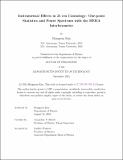Instrumental Effects in 21 cm Cosmology: One-point Statistics and Power Spectrum with the HERA Interferometer
Author(s)
Kim, Honggeun
DownloadThesis PDF (5.185Mb)
Advisor
Hewitt, Jacqueline N.
Terms of use
Metadata
Show full item recordAbstract
The epoch of reionization (EoR) signifies a critical phase in the universe’s evolution, marking the shift from a predominantly neutral intergalactic medium to the ionized state observed today. A key aspect of studying the EoR involves observing the redshifted 21 cm line emission with radio telescopes. A significant challenge in this endeavor is isolating the faint 21 cm signals from bright foreground emissions and systematics. This collection of works focuses on understanding the impact of instrumental systematic effects on statistical measurements, such as the one-point statistics and power spectrum, using the Hydrogen Epoch of Reionization Array (HERA). First, I investigate one-point statistics measured from image cubes based on HERA Phase I observations after foreground removal for the first time. I highlight the influence of systematics on these measurements, by measuring the second and third moments. These analyses show that, despite efforts to mitigate systematics, the residual systematics still cause deviations in the measurements from the expected values. In addition, I evaluate EoR models against observational data, suggesting the second moment measurements likely reject the cold reionization model characterized by inefficient X-ray heating. The third moment, which captures non-Gaussianity features of the signals, is significantly diminished by the instrument response and further reduced by the foreground removal process, making it challenging to probe non-Gaussianity. However, there remains the potential to detect some skewness at low redshifts. One potential systematic for HERA involves calibration errors stemming from per-antenna perturbations due to feed misalignment. I have simulated these calibration errors by modeling realistic perturbed primary beams for HERA Phase II observations. The chromatic calibration errors are critical since they can cause foreground emission to contaminate the region of Fourier space expected to be dominated by cosmological signals. I then present the work focused on developing a method to mitigate the calibration errors and foreground leakage, thereby recovering the clean EoR window.
Date issued
2024-09Department
Massachusetts Institute of Technology. Department of PhysicsPublisher
Massachusetts Institute of Technology